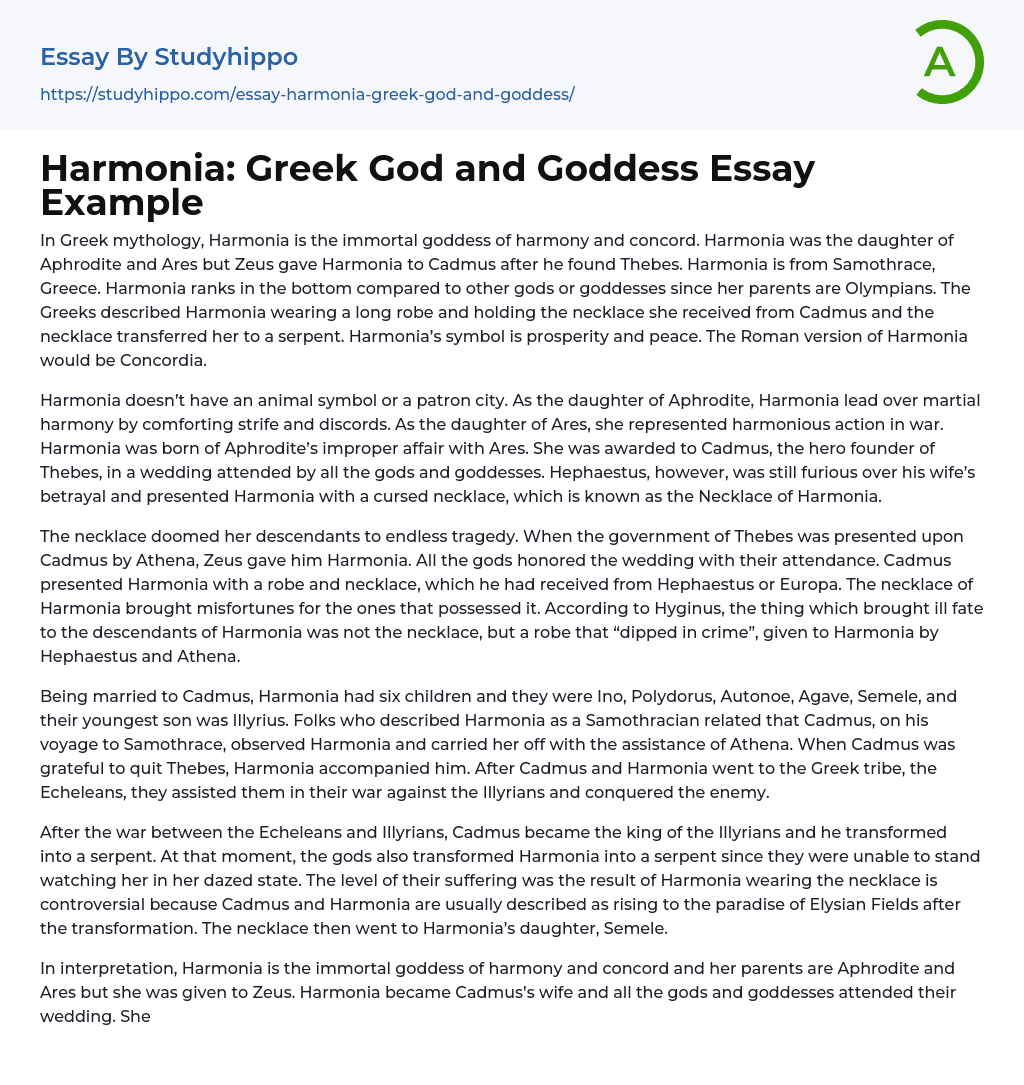Harmonia, in the context of Greek mythology, represents the eternal deity of harmony and agreement. She is the offspring of Aphrodite and Ares, however, Zeus gifted Harmonia to Cadmus upon his discovery of Thebes. Her roots trace back to Samothrace, Greece. Compared to other divine beings, her stature is relatively lower as she descends from the Olympians. The Greeks often depicted Harmonia in a flowing gown holding the necklace given by Cadmus which transformed her into a serpent. Her emblem signifies peace and abundance. In Roman mythology, she would be equated to Concordia.
Harmonia, who doesn't possess an animal symbol or a specific city under her patronage, is recognized for her influential role in martial harmony. Being Aphrodite's daughter, she is known for mitigating conflict and disagreements. Representing harmonious conduct in warfare as Ares' daughter, Harm
...onia was conceived during an illicit liaison between Aphrodite and Ares. Cadmus, the heroic founder of Thebes, was chosen to be her spouse in a magnificent wedding graced by the presence of all deities. However, Hephaestus continued to harbor anger over his wife's infidelity and consequently gifted Harmonia a cursed necklace, often referred to as the Necklace of Harmonia.
The lineage of those wearing the necklace was marred by continuous tragedies. When Athena handed the governance of Thebes over to Cadmus, Harmonia was given to him as a gift by Zeus. The celestial beings graced their nuptials with their presence. Cadmus gave Harmonia a wedding present in the form of a gown and necklace that he had acquired from Hephaestus or Europa. The necklace carried by Harmonia was a harbinger of distress for its bearers. However, Hyginus postulates that Harmonia's descendants suffere
due to a robe, soaked in guilt, bestowed upon her by Hephaestus and Athena, not the necklace.
Harmonia, married to Cadmus, was blessed with six children - Ino, Polydorus, Autonoe, Agave, Semele and the youngest one, Illyrius. Some people identified Harmonia as Samothracian and narrated an incident where Cadmus, on his journey to Samothrace, saw Harmonia and with Athena's help, eloped with her. When Cadmus finally decided to leave Thebes, Harmonia was by his side. Subsequently, Cadmus and Harmonia migrated to a Greek tribe called the Echeleans where they played a pivotal role in defeating their adversaries - the Illyrians.
Post the conflict between the Echeleans and Illyrians, Cadmus ascended the throne as an Illyrian king, and underwent a transformation into a serpent. Simultaneously, due to their inability to bear the sight of her bewildered state, the gods also morphed Harmonia into a serpent. The extent of their distress due to Harmonia's necklace is debatable because Cadmus and Harmonia are typically portrayed ascending to the Elysian Fields, a paradise, after their metamorphosis. The necklace subsequently passed on to Harmonia's daughter, Semele.
Harmonia, known as the eternal deity of harmony and peace, is a child of Aphrodite and Ares, though she was raised by Zeus. She tied the knot with Cadmus, an event which saw all divine beings in attendance. The pair were blessed with six offspring, with Illyrius being the youngest among them. On their nuptial day, Cadmus gifted Harmonia a necklace that unfortunately brought about calamities leading to both of them being morphed into snakes. Post transformation, they were relocated to the Island of the Blest where they lived peacefully for eternity.
- Creation Myth essays
- Creation Vs Evolution essays
- Afterlife essays
- Atheism essays
- Bible essays
- Buddhism essays
- Christian Worldview essays
- Christianity essays
- Confession essays
- Cosmological Argument essays
- Deism essays
- Devil essays
- Existence of God essays
- Faith essays
- Freedom Of Religion essays
- God essays
- Hinduism essays
- Immortality essays
- Islam essays
- Jainism essays
- Jews essays
- Judaism essays
- Miracle essays
- Monk essays
- Monotheism essays
- New Testament essays
- Old Testament essays
- Pilgrimage essays
- Puritans essays
- Revelation essays
- Ritual essays
- Salvation essays
- Sin essays
- Sinners essays
- Soul essays
- Taoism essays
- Temple essays
- Theology essays
- Agriculture essays
- Albert einstein essays
- Animals essays
- Archaeology essays
- Bear essays
- Biology essays
- Birds essays
- Butterfly essays
- Cat essays
- Charles Darwin essays
- Chemistry essays
- Dinosaur essays




